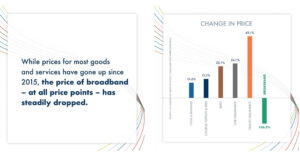August 13, 2021
A story in The New York Times this week caught my eye.
It looked at Washington’s inflation debate and how it could affect spending plans in Congress and the White House, pointing out: “For decades, prices have soared faster than incomes for many family necessities, including education and care for children and older people.”
The Times examined a new paper from the White House that took a deep dive into the cost of living for Americans over the last 30 years and how prices for necessities are eating up a larger and larger share of family budgets.
“Administration economists, in a new paper, argue that new spending plans would diminish the pain of those price pressures, contrary to a standard narrative that more spending increases inflation risk… The paper, published Wednesday by the Council of Economic Advisers and Office of Management and Budget, focuses on items that have gotten strikingly more expensive over many years.”
I’m not an economist… just a tech geek, but I have spent a lot of time studying the cost of broadband internet service (a necessity!) in the U.S. over the last several years – particularly how broadband prices stack up against other goods and services.
The White House paper acknowledges what constitutes a need can change over time, citing how “…high-speed Internet access became a necessity for school-age children when COVID-19 forced schools to shift to remote instruction.”
We actually looked at broadband prices going back well before the pandemic – to 2015 – for some hard data about how the cost of internet service has changed over time.
In a nutshell, our data indicates that while the cost of most goods and services are, in fact, going up, the cost of broadband – AT ALL PRICE POINTS – has been steadily dropping. At least 26 percent since 2015.
See for yourself: you can read the findings of our Broadband Pricing Index 2021 and 2020 reports here.
An example? The most popular tier of broadband service in 2015 was priced 20.2 percent lower in 2020. The price of the most popular tier of broadband service declined 7.5 percent from 2020 to 2021 – a one-year price decline of 9.3 percent when adjusted for inflation. We saw this at all price points.
(Speeds have gone up too, but that’s another subject entirely).

The White House cost of living report bears this out. The cost of food, rent, college education, health insurance and transportation are all up since 1990. The cost of computers notably dropped.
Our data is particularly timely as Congress wraps an infrastructure bill that set aside $65 billion for broadband deployment and affordability and prepares a budget. And while the White House has said broadband prices are “overpriced” and Americans “pay too much” the data says otherwise.
What does this tell us?
The right policies to spur investment and encourage innovation in the broadband sector are already in place. Consumers in the U.S. have access to world-class connectivity and affordable, high-value service plans. Now.
Affordability challenges remain an unacceptable issue for some (which is why the infrastructure funding is going to make a real difference), but broadband prices – unlike the cost of life’s other necessities are moving solidly in the right direction.
Let’s not mess with that.
Jonathan Spalter is President and CEO of USTelecom – The Broadband Association
###